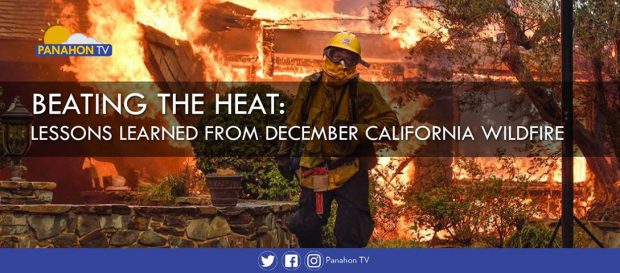Home > Blog > Global News
Beating the Heat: Lessons Learned from December California Wildfire

Within hours, a natural phenomenon can already reduce a beautiful mountainscape into a blazing inferno. Earlier this month, extreme fire conditions broke out in different parts of Southern California. The series of wildfires was ignited by powerful dry winds called Santa Ana winds, an annual occurrence in this part of California. The strong northeasterly winds originating from dry high-pressure air masses descended from the inland deserts funneling through coastal mountains through the Santa Ana Canyon. This condition caused the vegetation to dry out, making them more flammable.
Six major fires led to widespread evacuations and property losses.
THOMAS FIRE in VENTURA COUNTY
The biggest blaze in the state started as a 50-acre bush fire in the foothills east of Santa Paula. The devastation grew to 10,000 acres in just four hours. By early Friday, it swelled to over 132,000 acres. More than 88,000 residents have been evacuated.
CREEK FIRE in SYLMAR AREA
The fire has scorched more than 15,000 acres. Approximately 120,000 people have been evacuated with thousands of structures threatened. Wind speeds of 70 miles per hour is still fuelling the fire.
RYE FIRE in SANTA CLARITA AREA
The third bush fire has so far burned 7,000 acres in the Santa Clarita area even with 775 firefighters on the scene. About 2,000 residents have been evacuated.
SKIRBALL FIRE in LOS ANGELES COUNTY
Because of the fire, Interstate 405, one of America’s busiest highways, was temporarily closed. With the burning of 475 acres and counting, as well as several homes in the Bel Air area, Los Angeles County declared a state of emergency.
LILAC FIRE in SAN DIEGO COUNTY
Dubbed as an uncontrollable wildfire that reached peak gusts of 66 miles per hour, the Lilac Fire has devoured over 4,000 acres of land. California Governor Jerry Brown declared a state of emergency in the San Diego County.
LIBERTY FIRE in RIVERSIDE COUNTY
A bush fire has charred 300 acres and destroyed six outbuildings and a house. The Murrieta Mesa High School remains open as a shelter for evacuees.
Overall, the six blazes have burned close to 200,000 acres and forced over 212,000 residents from their homes. According to the California Department of Forestry and Fire Protection, 8,700 firefighters battled the first four large wildfires. A 70-year-old woman was identified as the first victim of the fires, while the Creek Fire was responsible for the death of almost 40 horses at Rancho Padilla.
WILDFIRE CAUSES
A Mediterranean Climate Zone prevails in most of California, characterized by virtually zero rainfall for half the year. The presence of Santa Ana winds makes California susceptible to fires all-year-round.
Forest fires always start either naturally caused or human caused. Natural fires are generally started by lightning, but in California’s fires, they are largely caused by dry conditions and the state’s Santa Ana winds. Still, the impact of wildfires can be reduced when greenhouse gas emissions are addressed.
Emissions worsen fires by altering precipitation and decreasing forest health, making forests more susceptible to severe fires. Destroyed forests may be unable to regenerate under changing climate conditions.
THE WORLD’S GREATEST FIRES
The Miramichi Fire (1825)
In October 1825, blazes lit up during a dry summer in Maine and the Canadian province of New Brunswick charring a massive 3 million acres. The fire killed 160 and left 15,000 homeless.
The Great Peshtigo Fire (1871)
3.7 million acres in Wisconsin and Michigan in October 1871 obliterated dozen of towns with flames that left 1,500 people cremated by heat that reached 2,000 degrees.
The Black Friday Bushfires (1939)
This is the most significant event in the environmental history of Victoria, Australia that nearly burned 5 million acres. About three-quarters of the state of Victoria were affected destroying entire towns and taking out 1,000 homes and 69 sawmills.
Greek Forest Fires (2007)
A series of massive forest fires in Greece stretched from June 28 to September 3, 2007. About 2,100 structures were destroyed in the fires, which scorched 670,000 acres and killed 84 people. Flames burned dangerously close to historic sites such as Olympia and Athens.
CONTROL AND PREVENTION
Over the years, forest wildfires have risen to the forefront of political and public awareness. International organizations and agencies continue to collaborate within the framework of the United Nations Forum on Forests to help build national capacities and support member countries in reducing adverse effects of fires. Other areas focused on are strengthening policy dialogue, dissemination of data, strategies related to early warning, prevention, management, control and remedial action and rehabilitation following forest fires.
Fires aren’t often declared as major disasters. Forest fires, however, are extremely dangerous. Residents and agencies should know how to avoid and respond to this emergency:
• Check local regulations regarding permit requirements “burn and ban” restrictions.
• Be prepared to extinguish the fire if it becomes a nuisance.
• Attend to the fire until it is completely out.
• Smoking should not be done while moving from one place to another in forest land.
• Cars, trucks and machinery must have proper exhaust systems when used in or near forest land.
• Know your local emergency telephone number if a fire becomes uncontrollable.
The Federal Emergency Management Agency (FEMA) has listed several recommendations on how homeowners in Wildland Urban Interface (WUI) high-risk areas can protect themselves:
• Construct homes with fire-resistant materials.
• Situate homes on lots to protect them from fire spread.
• Clear a perimeter of defensible space around homes.
• Install smoke alarms.
• Develop and practice evacuation plans in the event of a wildfire.
• Responsible human behavior can help reduce the number of forest fires to a great extent.









